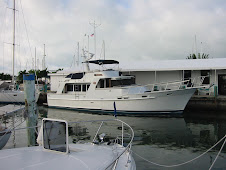Today we departed Elizabeth City after this commercial tow went through the bridge.
Two trawlers, whose owners had stopped by our boat yesterday to chat, followed us. We got to know them via radio as we all transited the long-anticipated Dismal Swamp Canal.
This bridge opening looked too skinny for Monarch to slip through, but Captain Jerry did a fine job.

The first part of the Canal was a serpentine natural river. Further on, the manmade parts of the canal were constructed following the Revolutionary War. Both George Washington and Patrick Henry felt that this would be the best route for transportation of goods to the area’s isolated towns and villages.

The canal was dug completely by hand, most of the slave labor provided by local landowners. It is the oldest operating artificial waterway in the United States. In most areas, the canal is very narrow, and also shallow, with many submerged objects that were kicked up by our propellers, causing bumps and thuds! But apparently no damage.

The lockmaster operates the lock and an adjacent bridge. After helping us get tied up in the lock, and completing our lift up, he jumped in his pickup and raced to the bridge to open it for us.

The Dismal Swamp State Park’s headquarters is located about halfway up the canal. A park interpretive center is on one side of the canal; across the canal is a freeway welcome center. The two are linked via this pedestrian pontoon bridge, which the ranger opened for our passage.

This shows just how close the banks were to the boat as we passed. Most of the banks were undeveloped and impenetrable wilderness, as it was when the canal was dug. Slaves who originally built the canal became so familiar with the swamp that it became a haven for runaways.

We were officially welcomed to Virginia. On this site, the infamous “Halfway House” hotel was built in the late 1820’s. The hotel straddled the state line, and was a popular haven for criminals “on the lam” who avoided capture simply by walking to the other side of the hotel.

Colonel William Byrd II of Virginia first surveyed this area in 1728. After slogging through the dense undergrowth and forests of the great swamp, he termed it “dismal.” The canal seemed anything but “dismal” to us! Our trip reminded us of a nice Sunday drive on a country road.
We almost could reach out and pick a bouquet of these flowers.

The canal bisects a farmer’s property, and he has permission to slide this bridge across whenever he needs to get his cows or tractors from one bank to the other!

This is an original mile marker for the canal, which opened in 1805. At a number of these spots, pocket parks have been established for bikers, hikers and drivers.

At the end of the day, we stopped just short of the second and final lock on the Canal. We tied up at Elizabeth’s Dock, established by a local man in honor of his wife, which transient boats may use at no charge. It was a nice dock adjacent to a lovely park.











No comments:
Post a Comment